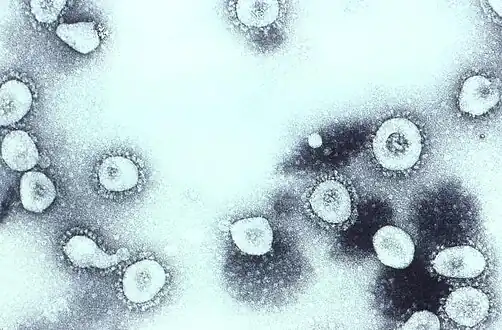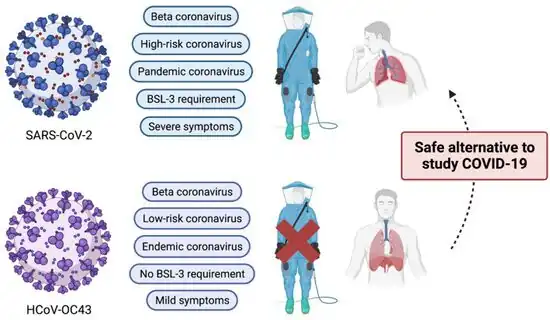Human coronavirus OC43
| Human coronavirus OC43 | |
|---|---|
 | |
| Transmission electron micrograph of human coronavirus OC43 | |
| Virus classification | |
| (unranked): | Virus |
| Realm: | Riboviria |
| Kingdom: | Orthornavirae |
| Phylum: | Pisuviricota |
| Class: | Pisoniviricetes |
| Order: | Nidovirales |
| Family: | Coronaviridae |
| Genus: | Betacoronavirus |
| Subgenus: | Embecovirus |
| Species: | |
| Virus: | Human coronavirus OC43 |
Human coronavirus OC43[1] (HCoV-OC43) is a member of the species Betacoronavirus 1, which infects humans and cattle.[2][3] The infecting coronavirus is an enveloped, positive-sense, single-stranded RNA virus that enters its host cell by binding to the N-acetyl-9-O-acetylneuraminic acid receptor.[4] OC43 is one of seven coronaviruses known to infect humans. It is one of the viruses responsible for the common cold[5][6] and may have been responsible for the 1889–1890 pandemic.[7] It has, like other coronaviruses from genus Betacoronavirus, subgenus Embecovirus, an additional shorter spike protein called hemagglutinin-esterase (HE).[8][2]
Virology

Four HCoV-OC43 genotypes (A to D) have been identified, with genotype D most likely arising from genetic recombination. The complete genome sequencing of genotypes C and D and bootscan analysis shows recombination events between genotypes B and C in the generation of genotype D. Of 29 viral variants identified, none belong to the more ancient genotype A. Molecular clock analysis using spike and nucleocapsid genes dates the most recent common ancestor of all genotypes to the 1950s. Genotype B and C date to the 1980s. Genotype B to the 1990s, and genotype C to the late 1990s to early 2000s. The recombinant genotype D variants were detected as early as 2004.[5]
Comparison of HCoV-OC43 with the most closely related strain of Betacoronavirus 1 species, bovine coronavirus BCoV, indicated that they had a most recent common ancestor in the late 19th century, with several methods yielding most probable dates around 1890, leading authors to speculate that an introduction of the former strain to the human population might have caused the 1889–1890 pandemic, which at the time was attributed to influenza.[9] The COVID-19 pandemic brought further evidence of a link, as the 1889–1890 pandemic produced symptoms closer to those associated with COVID-19 (the infection caused by the SARS-CoV-2 betacoronavirus) than to influenza.[10] Brüssow, in August 2021, referred to the evidence that OC43 caused the 1889–1890 outbreak as "indirect, albeit weak" and was "conjectural", yet the 1889 epidemic was the best historical record to make predictions about the current COVID-19 path due to the similar "clinical and epidemiological characteristics".[11]
The origin of HCoV-OC43 is uncertain, but it is thought that it may have originated in rodents, then passed through cattle as intermediate hosts.[12] A deletion from BCoV to HCoV-OC43 may have taken place for the interspecies transmission event from bovines to humans.[9]
Infection
Along with HCoV-229E, a species in the genus Alphacoronavirus, HCoV-OC43 is among the viruses that cause the common cold. Both viruses can cause severe lower respiratory tract infections, including pneumonia in infants, the elderly, and immunocompromised individuals such as those undergoing chemotherapy and those with HIV/AIDS.[13][14][15]
If HCoV-OC43 was indeed the pathogen responsible for the 1889–1890 pandemic, which resembled the COVID-19 pandemic, severe disease was much more common and mortality much higher in populations that had not previously been exposed.[16]
Epidemiology
Coronaviruses have a worldwide distribution, causing 10–15% of common cold cases (the virus most commonly implicated in the common cold is a rhinovirus, found in 30–50% of cases).[17] Infections show a seasonal pattern with most cases occurring in the winter months in temperate climates, and summer and spring in warm climates.[18][17][19][20]
See also
References
- ↑ Lee, Paul (2007). Molecular epidemiology of human coronavirus OC43 in Hong Kong (Thesis). The University of Hong Kong Libraries. doi:10.5353/th_b4501128. hdl:10722/131538.
- 1 2 "Taxonomy browser (Betacoronavirus 1)". www.ncbi.nlm.nih.gov. Archived from the original on 2020-11-05. Retrieved 2020-02-29.
- ↑ Lim, Yvonne Xinyi; Ng, Yan Ling; Tam, James P.; Liu, Ding Xiang (2016-07-25). "Human Coronaviruses: A Review of Virus–Host Interactions". Diseases. 4 (3): 26. doi:10.3390/diseases4030026. PMC 5456285. PMID 28933406.
See Table 1.
- ↑ Li, Fang (2016-09-29). "Structure, Function, and Evolution of Coronavirus Spike Proteins". Annual Review of Virology. 3 (1): 237–261. doi:10.1146/annurev-virology-110615-042301. PMC 5457962. PMID 27578435.
BCoV S1-NTD does not recognize galactose as galectins do. Instead, it recognizes 5-N-acetyl-9-O-acetylneuraminic acid (Neu5,9Ac2) (30, 43). The same sugar receptor is also recognized by human coronavirus OC43 (43, 99). OC43 and BCoV are closely related genetically, and OC43 might have resulted from zoonotic spillover of BCoV (100, 101).
- 1 2 Lau, Susanna K. P.; Lee, Paul; Tsang, Alan K. L.; Yip, Cyril C. Y.; Tse, Herman; Lee, Rodney A.; So, Lok-Yee; Lau, Y.-L.; Chan, Kwok-Hung; Woo, Patrick C. Y.; Yuen, Kwok-Yung (2011). "Molecular Epidemiology of Human Coronavirus OC43 Reveals Evolution of Different Genotypes over Time and Recent Emergence of a Novel Genotype due to Natural Recombination". Journal of Virology. 85 (21): 11325–37. doi:10.1128/JVI.05512-11. PMC 3194943. PMID 21849456.
- ↑ Gaunt, E.R.; Hardie, A.; Claas, E.C.J.; Simmonds, P.; Templeton, K.E. (2010). "Epidemiology and clinical presentations of the four human coronaviruses 229E, HKU1, NL63, and OC43 detected over 3 years using a novel multiplex real-time PCR method". J Clin Microbiol. 48 (8): 2940–7. doi:10.1128/JCM.00636-10. PMC 2916580. PMID 20554810.
- ↑ Brüssow, Harald; Brüssow, Lütz (13 July 2021). "Clinical evidence that the pandemic from 1889 to 1891 commonly called the Russian flu might have been an earlier coronavirus pandemic". Microbial Biotechnology. 14 (5): 1860–1870. doi:10.1111/1751-7915.13889. PMC 8441924. PMID 34254725.
- ↑ Woo, Patrick C. Y.; Huang, Yi; Lau, Susanna K. P.; Yuen, Kwok-Yung (2010-08-24). "Coronavirus Genomics and Bioinformatics Analysis". Viruses. 2 (8): 1804–20. doi:10.3390/v2081803. PMC 3185738. PMID 21994708.
In all members of Betacoronavirus subgroup A, a haemagglutinin esterase (HE) gene, which encodes a glycoprotein with neuraminate O-acetyl-esterase activity and the active site FGDS, is present downstream to ORF1ab and upstream to S gene (Figure 1).
- 1 2 Vijgen, Leen; Keyaerts, Els; Moës, Elien; Thoelen, Inge; Wollants, Elke; Lemey, Philippe; Vandamme, Anne-Mieke; Van Ranst, Marc (2005). "Complete Genomic Sequence of Human Coronavirus OC43: Molecular Clock Analysis Suggests a Relatively Recent Zoonotic Coronavirus Transmission Event". Journal of Virology. 79 (3): 1595–1604. doi:10.1128/JVI.79.3.1595-1604.2005. PMC 544107. PMID 15650185.
- ↑ Knudsen, Jeppe Kyhne (13 August 2020). "Overraskende opdagelse: Coronavirus har tidligere lagt verden ned" [Surprising discovery: Coronavirus has previously brought down the world]. DR (in dansk). Archived from the original on 13 August 2020. Retrieved 13 August 2020.
A presumed influenza pandemic in 1889 was actually caused by coronavirus, Danish research shows.
- ↑ Brüssow, Harald (2021). "What we can learn from the dynamics of the 1889 'Russian flu' pandemic for the future trajectory of COVID-19". Microbial Biotechnology. 14 (6): 2244–2253. doi:10.1111/1751-7915.13916. PMC 8601188. PMID 34464023.
- ↑ Forni, Diego; Cagliani, Rachele; Clerici, Mario; Sironi, Manuela (2017). "Molecular Evolution of Human Coronavirus Genomes". Trends in Microbiology. 25 (1): 35–48. doi:10.1016/j.tim.2016.09.001. ISSN 0966-842X. PMC 7111218. PMID 27743750.
- ↑ Wevers, Brigitte A.; Van Der Hoek, Lia (2009). "Recently Discovered Human Coronaviruses". Clinics in Laboratory Medicine. 29 (4): 715–724. doi:10.1016/j.cll.2009.07.007. PMC 7131583. PMID 19892230.
- ↑ Mahony, James B. (2007). "Coronaviruses". In Murray, Patrick R.; Baron, Ellen Jo; Jorgensen, James H.; Landry, Marie Louise; Pfaller, Michael A. (eds.). Manual of Clinical Microbiology (9th ed.). Washington D.C.: ASM Press. pp. 1414–23. ISBN 978-1-55581-371-0.
- ↑ Pyrc, K.; Berkhout, B.; Van Der Hoek, L. (2007). "Antiviral Strategies Against Human Coronaviruses". Infectious Disorders Drug Targets. 7 (1): 59–66. doi:10.2174/187152607780090757. PMID 17346212.
- ↑ Brüssow, Harald; Brüssow, Lütz (13 July 2021). "Clinical evidence that the pandemic from 1889 to 1891 commonly called the Russian flu might have been an earlier coronavirus pandemic". Microbial Biotechnology. 14 (5): 1860–1870. doi:10.1111/1751-7915.13889. PMC 8441924. PMID 34254725.
- 1 2 Wat, Dennis (2004). "The common cold: A review of the literature". European Journal of Internal Medicine. 15 (2): 79–88. doi:10.1016/j.ejim.2004.01.006. PMC 7125703. PMID 15172021.
- ↑ Van Der Hoek, L (2007). "Human coronaviruses: What do they cause?". Antiviral Therapy. 12 (4 Pt B): 651–8. doi:10.1177/135965350701200S01.1. PMID 17944272. S2CID 31867379. Archived from the original on 2022-01-28. Retrieved 2020-04-05.
- ↑ Kissler, Stephen M. (April 14, 2020). "Projecting the transmission dynamics of SARS-CoV-2 through the postpandemic period". Science. 368 (6493): 860–868. Bibcode:2020Sci...368..860K. doi:10.1126/science.abb5793. PMC 7164482. PMID 32291278.
{{cite journal}}: CS1 maint: date and year (link) - ↑ Berry, Michael (2015). "Identification of New Respiratory Viruses in the New Millennium". Viruses. 7 (3): 996–1019. doi:10.3390/v7030996. PMC 4379558. PMID 25757061.
External links
| Wikispecies has information related to Human coronavirus OC43 |
- Virology online Archived 2017-10-10 at the Wayback Machine
- Coronaviruses
- Viralzone: Betacoronavirus Archived 2017-02-10 at the Wayback Machine
- Virus Pathogen Database and Analysis Resource (ViPR): Coronaviridae Archived 2013-03-12 at the Wayback Machine